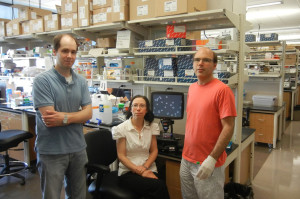
Genome Editing, or the ability to make designer changes to the human genome, was once firmly in the realm of science fiction, but recent discoveries have changed that. Although it is still not possible to change the genome of all cells in an individual’s body, it is now possible to make designer changes in cells from that individual grown in the Petri dish in the lab. These changes can allow us to prove or disprove hypotheses about the cause of FSHD,
and when done in stem cells, they might pave the way for a future cell therapy where a patient’s own cells are genetically corrected and used to replace affected muscle with healthy muscle.
The FSH Society and FSHD Canada are jointly funding a project called “Exploiting Genome Editing Technologies,” led by Michael Kyba, PhD, Lillehei Endowed Scholar and Associate Professor of Pediatrics at the University of Minnesota. The two FSHD organizations joined forces last year to support the first year of the $125,000 project, with each putting in $62,500. Based on the success of the first year, they agreed to fund the second year of the project for the same amount.
“The past several years have seen tremendous advances in our ability to specifically modify DNA sequences in the human genome,” said Kyba. “FSHD is caused by the combination of two factors: the contraction of D4Z4 repeat number combined with the presence of a disease-causing sequence downstream of the D4Z4 repeats. Both of these DNA elements are accessible to modification using newly developed genome editing technology.” The Kyba lab has developed methods of gene targeting (using a technology called site-specific nucleases) that address both elements and is using these to derive and study genetically corrected FSHD cell lines.
Details on Dr. Kyba’s project:
Sequence-specific nucleases cut the DNA molecule at defined sequences. If the sequence-specific nuclease is designed to a particular site, for example the FSHD locus, they allow scientists to make designed changes at that site. The Kyba Laboratory has been using working with two types of sequence-specific nucleases, called a zinc finger-nuclease, and TALENs, however a new technology has recently come on the scene, referred to as CRISPR/Cas9. This technology allows much more rapid development and testing of genome editing approaches. This grant allows the lab to apply this new technology to genome editing projects. The grant has 3 overall goals: 1. They specifically plan to use CRISPR/Cas9 to modify the “pathogenic poly A sequence”, which is the FSHD-causing sequence that lies on the far side of the D4Z4 repeats. The cells they will use for these studies are human induced pluripotent cells from FSHD donors. These are cells from an adult donor that have been reprogrammed to behave like embryonic cells, with unlimited proliferation and differentiation potential, thus once genetically corrected they should be able to generate muscle stem cells that lack the FSHD mutation. 2. The funding will also allow the lab to perform genome editing on embryonic stem cells carrying the FSHD mutation. 3. The lab will use the technology to make defined changes in the way that DNA at the FSHD locus on chromosome 4 is packaged, in order to test models for the molecular mechanism underlying FSHD. These studies are proceeding apace and promise to shed light on new approaches for therapy development.
For technical details on Dr. Kyba’s project, please visit Grants We Have Funded and look under grants from the August 2013 cycle.


I am from India and my brother recently diagnosed fshd muscle dystrophy. Please let me know if there is any cure or chances of cure. Thanks
Unfortunately there is no cure today, but with the understanding we now have of the genetic origins of FSHD, many researchers are investigating ideas for future therapies, and a growing number of biotech companies are developing potential treatments.